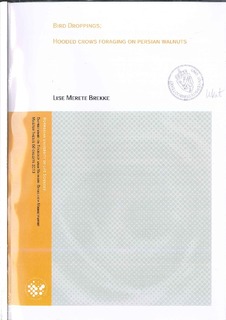| dc.description.abstract | I conducted a study on hooded crows (Corvus corone cornix) foraging on walnuts (Juglans regia), often in the presence of magpies (Pica pica). The fieldwork was conducted around three mature walnut trees in a residential neighborhood in Oslo, Norway. The crows would drop walnuts to break them, and were found to use a drop height and -surface that would optimize energy output. In contrast to what other studies have found, the crows did not seem to adjust drop height to the number of conspecifics nearby. Instead, I found a positive effect of the number of magpies nearby as well as an effect of wind. The rate of kleptoparasitism was comparable to similar studies, and the crows may try to avoid being parasitized by means such as flying away from the drop site more often at increased risk of kleptoparasitism.
Both magpies and crows were more likely to approach a nut owner after a successful drop where the nut cracked, and nuts were more likely to be stolen after having cracked. On the other hand, crows were more likely to fly away after a drop when approached by other corvids and with increasing wind, but also after or near successful drops. | no_NO |
